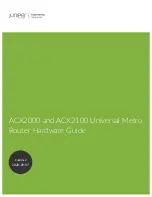
Protocol-Based VLAN
91
c
CAUTION:
You are recommended to set the default VLAN ID of the local Hybrid
or Trunk ports to the same value as that of the Hybrid or Trunk ports on the peer
switch. Otherwise, packet forwarding may fail on the ports.
Protocol-Based VLAN
Introduction to
Protocol-Based VLAN
Protocol-based VLAN is also known as protocol VLAN, which is another way to
classify VLANs besides port-based VLAN. Through the protocol-based VLANs, the
switch can analyze the received un-VLAN-tagged packets on the port and match
the packets with the user-defined protocol template automatically according to
different encapsulation formats and the values of the special fields. If a packet is
matched, the switch will add a corresponding VLAN tag to it automatically. Thus,
the data of the specific protocol is assigned automatically to the corresponding
VLAN for transmission.
This feature is used for binding the ToS provided in the network to VLAN to
facilitate management and maintenance.
Encapsulation Format of
Ethernet Data
This section introduces the common encapsulation formats of Ethernet data for
you to understand well the procedure for the switch to identify the packet
protocols.
Ethernet II and 802.2/802.3 encapsulation
In the link layer, there are two main packet encapsulation types: Ethernet II and
802.2/802.3, whose encapsulation formats are described in the following figures.
Ethernet II packet:
Figure 28
Ethernet II encapsulation format
802.2/802.3 standard packet:
Figure 29
802.2/802.3 standard encapsulation format
Table 44
Packet processing of a Hybrid port
Processing of an incoming packet
Processing of an outgoing
packet
If the packet does not
carry a VLAN tag
If the packet carries a VLAN
tag
If the port is already added
to its default VLAN, add the
default VLAN tag to the
packet and then forward the
packet.
If the port is not added to its
default VLAN, discard the
packet.
If the VLAN ID is one of the
VLAN IDs allowed to pass
through the port, receive the
packet.
If the VLAN ID is not one of
the VLAN IDs allowed to pass
through the port, discard the
packet.
Send the packet if the VLAN
ID is allowed to pass through
the port. Use the
port hybrid
vlan
command to configure
whether the port keeps or
strips the tags when sending
packets of a VLAN (including
the default VLAN).
DA&SA(12)
Type(2)
Data
DA&SA(12)
Length(2)
Data
DSAP(1)
SSAP(1)
Control(1)
OUI(3)
PID(2)
Summary of Contents for Switch 7754
Page 32: ...32 CHAPTER 1 CLI OVERVIEW ...
Page 70: ...70 CHAPTER 5 LOGGING IN USING MODEM ...
Page 76: ...76 CHAPTER 7 LOGGING IN THROUGH NMS ...
Page 86: ...86 CHAPTER 9 CONFIGURATION FILE MANAGEMENT ...
Page 120: ...120 CHAPTER 13 ISOLATE USER VLAN CONFIGURATION ...
Page 126: ...126 CHAPTER 14 SUPER VLAN ...
Page 136: ...136 CHAPTER 16 IP PERFORMANCE CONFIGURATION ...
Page 152: ...152 CHAPTER 17 IPX CONFIGURATION ...
Page 164: ...164 CHAPTER 19 QINQ CONFIGURATION ...
Page 172: ...172 CHAPTER 21 SHARED VLAN CONFIGURATION ...
Page 182: ...182 CHAPTER 22 PORT BASIC CONFIGURATION ...
Page 198: ...198 CHAPTER 24 PORT ISOLATION CONFIGURATION ...
Page 208: ...208 CHAPTER 25 PORT SECURITY CONFIGURATION ...
Page 224: ...224 CHAPTER 27 DLDP CONFIGURATION ...
Page 232: ...232 CHAPTER 28 MAC ADDRESS TABLE MANAGEMENT ...
Page 240: ...240 CHAPTER 29 CENTRALIZED MAC ADDRESS AUTHENTICATION CONFIGURATION ...
Page 280: ...280 CHAPTER 30 MSTP CONFIGURATION ...
Page 348: ...348 CHAPTER 35 IS IS CONFIGURATION ...
Page 408: ...408 CHAPTER 39 802 1X CONFIGURATION ...
Page 412: ...412 CHAPTER 40 HABP CONFIGURATION ...
Page 422: ...422 CHAPTER 41 MULTICAST OVERVIEW ...
Page 426: ...426 CHAPTER 42 GMRP CONFIGURATION ...
Page 480: ...480 CHAPTER 47 PIM CONFIGURATION ...
Page 506: ...506 CHAPTER 48 MSDP CONFIGURATION ...
Page 552: ...552 CHAPTER 51 TRAFFIC ACCOUNTING CONFIGURATION ...
Page 570: ...570 CHAPTER 53 HA CONFIGURATION ...
Page 582: ...582 CHAPTER 54 ARP CONFIGURATION SwitchA arp protective down recover interval 200 ...
Page 622: ...622 CHAPTER 58 DHCP RELAY AGENT CONFIGURATION ...
Page 684: ...684 CHAPTER 61 QOS CONFIGURATION ...
Page 718: ...718 CHAPTER 63 CLUSTER ...
Page 738: ...738 CHAPTER 67 UDP HELPER CONFIGURATION ...
Page 752: ...752 CHAPTER 69 RMON CONFIGURATION ...
Page 772: ...772 CHAPTER 70 NTP CONFIGURATION ...
Page 796: ...796 CHAPTER 72 FILE SYSTEM MANAGEMENT ...
Page 802: ...802 CHAPTER 73 BIMS CONFIGURATION ...
Page 814: ...814 CHAPTER 74 FTP AND TFTP CONFIGURATION ...
Page 830: ...830 CHAPTER 75 INFORMATION CENTER ...
Page 836: ...836 CHAPTER 76 DNS CONFIGURATION ...
Page 852: ...852 CHAPTER 77 BOOTROM AND HOST SOFTWARE LOADING ...
Page 858: ...858 CHAPTER 78 BASIC SYSTEM CONFIGURATION DEBUGGING ...
















































